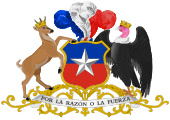| Provinces of Chile Provincias de Chile (Spanish) | |
|---|---|
 | |
| Category | Unitary unit |
| Location | |
| Number | 56 |
| Populations | 2,392 (Antártica Chilena) – 4,997,637 (Santiago Province) |
| Areas | 163.6 km2 (63.2 sq mi) (Isla de Pascua) - 67,813.5 km2 (26,182.9 sq mi) (Antofagasta) |
| Government |
|
| Subdivisions | |
 |
|---|
|
|
A province is a second-level administrative division in Chile. There are 56 in total. The top-level administrative division in Chile is the region. There are 16 in total.
Each provincial presidential delegation (delegación presidencial provincial) is headed by a provincial presidential delegate (delegado presidencial provincial) appointed by the President. The governor exercises their powers in accordance with instructions from the regional presidential delegate (delegado presidencial regional). The provincial delegate is advised by the Provincial Economic and Social Council (Consejo Económico y Social Provincial or CESPRO). No provincial presidential delegations exist in those provinces where the regional capital is located; its functions were merged with those of the regional presidential delegate.
The country's provinces are further divided into 346 communes which are administered by an alcalde and municipal council.
Until 1976, the 25 provinces were the broadest administrative division in Chile. They were: Aconcagua, Aysén (since 1929), Antofagasta, Arauco, Atacama, Biobío, Cautín, Chiloé, Colchagua, Concepción, Coquimbo, Curicó, Linares, Llanquihue, Magallanes (since 1929), Malleco, Maule, Ñuble, O'Higgins, Osorno (since 1940), Santiago, Talca, Tarapacá, Valdivia, and Valparaíso.
Chile claims part of Antarctica which it includes in the Antártica Chilena province. Generally, only the South American part of that province is recognized as part of Chile.